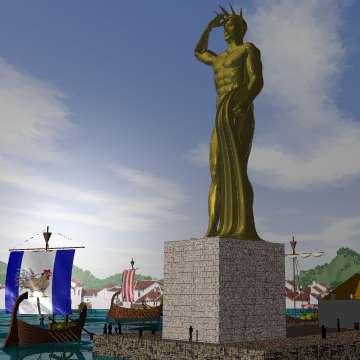The temple of Artemis at Ephesus
The Mausoleum at Halicarnassus
The Hanging Gardens of Babylon
Built: Early 200s B.C.
Location: Near harbor of Rhodes, a Greek island in Aegean Sea
History: The Greek sculptor Chares and his shop worked 12 years to build a giant bronze statue in honor of the sun god Helios. The statue, celebrating the unity of Rhodes' three city-states, is believed to have stood on a promontory overlooking the water.
At approximately 120 feet, the bronze Colossus stood almost as high as the Statue of Liberty in the United States. Interior stone blocks and iron bars supported the hollow statue. Just 56 years after it was built, a strong earthquake destroyed it.
The island of Rhodes was an important economic centre in the ancient world. It is located off the southwestern tip of Asia Minor where the Aegean Sea meets the Mediterranean. The capitol city, also named Rhodes, was built in 408 B.C. and was designed to take advantage of the island's best natural harbour on the northern coast. In 357 B.C. the island was conquered by Mausolus of Halicarnassus (whose tomb is one of the other Seven Wonders of the Ancient World), fell into Persian hands in 340 B.C., and was finally captured by Alexander the Great in 332 B.C..
When Alexander died of a fever at an early age, his generals fought bitterly among themselves for control of Alexander's vast kingdom. Three of them, Ptolemy, Seleucus, and Antigous, succeeded in dividing the kingdom among themselves. The Rhodians supported Ptolemy (who wound up ruling Egypt) in this struggle. This angered Antigous who sent his son Demetrius to capture and punish the city of Rhodes. The war was long and painful. Demetrius brought an army of 40,000 men. This was more than the entire population of Rhodes.
When Demetrius attacked the city, the defenders stopped the war machine by flooding a ditch outside the walls and mining the heavy monster in the mud. By then almost a year had gone by and a fleet of ships from Egypt arrived to assist the city. Demetrius withdrew quickly leaving the great siege tower where it was. To celebrate their victory and freedom, the Rhodians decided to build a giant statue of their patron god Helios. They melted down bronze from the many war machines Demetrius left behind for the exterior of the figure and the super siege tower became the scaffolding for the project. According to Pliny, a historian who lived several centuries after the Colossus was built, construction took 12 years. Other historians place the start of the work in 304 B.C.. The statue was one hundred and ten feet high and stood upon a fifty-foot pedestal near the harbour mole. Although the statue has been popularly depicted with its legs spanning the harbour entrance so that ships could pass beneath, it was actually posed in a more traditional Greek manner: nude, wearing a spiked crown, shading its eyes from the rising sun with its right hand, while holding a cloak over its left.
The architect of this great construction was Chares of Lindos, a Rhodian sculptor who was a patriot and fought in defence of the city. Chares had been involved with large scale statues before. His teacher, Lysippus, had constructed a 60-foot high likeness of Zeus. Chares probably started by making smaller versions of the statue, maybe three feet high, then used these as a guide to shaping each of the bronze plates of the skin.
The Colossus stood proudly at the harbour entrance for some fifty-six years. Each morning the sun must have caught its polished bronze surface and made the god's figure shine. Then an earthquake hit Rhodes and the statue collapsed. Huge pieces of the figure lay along the harbour for centuries. It is said that an Egyptian king offered to pay for its reconstruction, but the Rhodians refused. They feared that somehow the statue had offended the god Helios, who used the earthquake to throw it down.
In the seventh century A.D. the Arabs conquered Rhodes and broke the remains of the Colossus up into smaller pieces and sold it as scrap metal. Legend says it took 900 camels to carry away the statue. A sad end for what must have been a majestic work of art.

